New Method Simplifies Preparation of Tumor Genomic DNA Libraries
|
By LabMedica International staff writers Posted on 28 Oct 2019 |
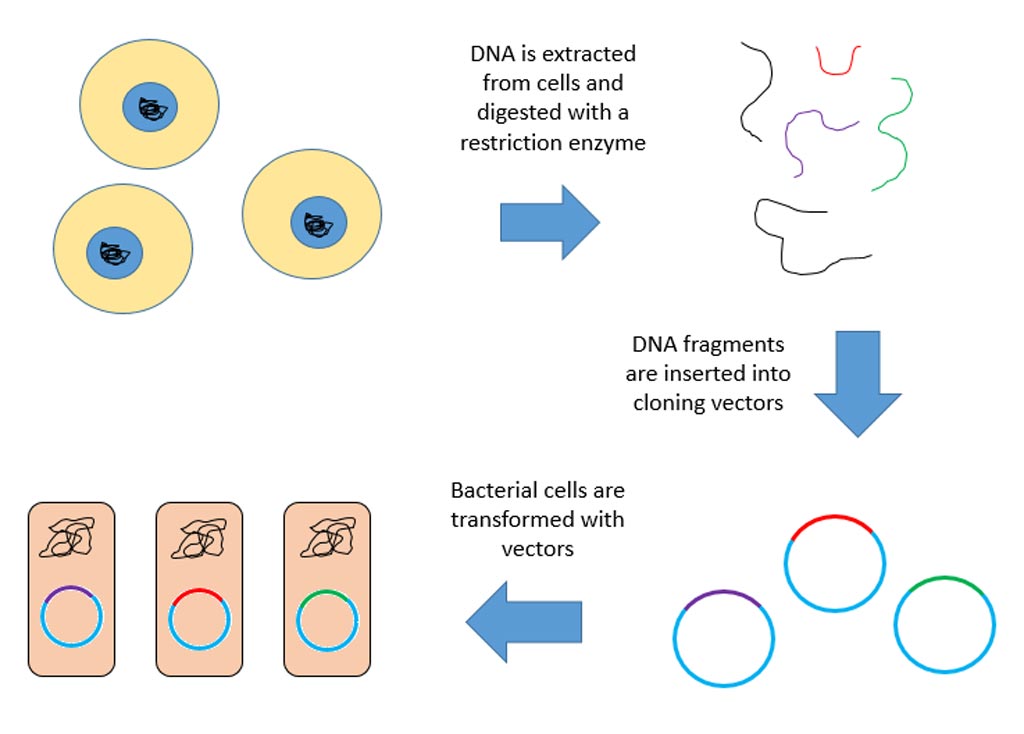
Image: A diagram of construction of a genomic library (Photo courtesy of Wikimedia Commons).
A method has been described that simplifies preparation of tumor genomic DNA libraries by employing restriction enzymes and in vitro transcription to barcode and amplify genomic DNA prior to library construction.
In general, a genomic library is the collection of the total genomic DNA from a single organism. The DNA is stored in a population of identical vectors, each containing a different insert of DNA. In order to construct a genomic library, the organism's DNA is extracted from cells and then digested with a restriction enzyme to cut the DNA into fragments of a specific size. The fragments are then inserted into the vector using DNA ligase.
Copy number alterations or variations are common features of cancer cells. Within the same tumor, cells belonging to different anatomical areas of the tumor may carry different variations. Tumors with many variations are typically very aggressive and tend to be resistant to treatment.
Current strategies for massively parallel sequencing of tumor genomic DNA mainly rely on library indexing in the final steps of library preparation. This procedure is costly and time-consuming, since a library must be generated separately for each sample. Furthermore, whole-genome amplification requires intact DNA and thus is problematic in fixed tissue samples, in particular formalin-fixed, paraffin-embedded (FFPE) specimens, which still represent a cornerstone in pathology.
To overcome these limitations, investigators at the Karolinska Institutet (Solna, Sweden) developed a method, which they named CUTseq, that combined restriction endonucleases with in vitro transcription (IVT) to construct highly multiplexed DNA libraries for reduced representation genome sequencing of multiple samples in parallel.
The investigators showed that CUTseq could be used to barcode gDNA extracted from both non-fixed and fixed samples, including old archival FFPE tissue sections. They benchmarked CUTseq by comparing it with a widely used method of DNA library preparation and demonstrated that CUTseq could be used for reduced representation genome and exome sequencing, enabling reproducible DNA copy number profiling and single-nucleotide variant (SNV) calling in both cell and low-input FFPE tissue samples.
The investigators demonstrated an application of CUTseq for assessing genetic differences within tumors by profiling DNA copy number levels in multiple small regions of individual FFPE tumor sections. Finally, they described a workflow for rapid and cost-effective preparation of highly multiplexed CUTseq libraries, which could be applied in the context of high-throughput genetic screens and for cell line authentication.
"I expect that CUTseq will find many useful applications in cancer diagnostics," said senior author Dr. Nicola Crosetto, senior researcher in medical biochemistry and biophysics at the Karolinska Institutet. "Multi-region tumor sequencing is going to be increasingly used in the diagnostic setting, in order to identify patients with highly heterogeneous tumors that need to be treated more aggressively. I believe that our method can play a leading role here."
The study was published in the October 18, 2019, online edition of the journal Nature Communications.
Related Links:
Karolinska Institutet
In general, a genomic library is the collection of the total genomic DNA from a single organism. The DNA is stored in a population of identical vectors, each containing a different insert of DNA. In order to construct a genomic library, the organism's DNA is extracted from cells and then digested with a restriction enzyme to cut the DNA into fragments of a specific size. The fragments are then inserted into the vector using DNA ligase.
Copy number alterations or variations are common features of cancer cells. Within the same tumor, cells belonging to different anatomical areas of the tumor may carry different variations. Tumors with many variations are typically very aggressive and tend to be resistant to treatment.
Current strategies for massively parallel sequencing of tumor genomic DNA mainly rely on library indexing in the final steps of library preparation. This procedure is costly and time-consuming, since a library must be generated separately for each sample. Furthermore, whole-genome amplification requires intact DNA and thus is problematic in fixed tissue samples, in particular formalin-fixed, paraffin-embedded (FFPE) specimens, which still represent a cornerstone in pathology.
To overcome these limitations, investigators at the Karolinska Institutet (Solna, Sweden) developed a method, which they named CUTseq, that combined restriction endonucleases with in vitro transcription (IVT) to construct highly multiplexed DNA libraries for reduced representation genome sequencing of multiple samples in parallel.
The investigators showed that CUTseq could be used to barcode gDNA extracted from both non-fixed and fixed samples, including old archival FFPE tissue sections. They benchmarked CUTseq by comparing it with a widely used method of DNA library preparation and demonstrated that CUTseq could be used for reduced representation genome and exome sequencing, enabling reproducible DNA copy number profiling and single-nucleotide variant (SNV) calling in both cell and low-input FFPE tissue samples.
The investigators demonstrated an application of CUTseq for assessing genetic differences within tumors by profiling DNA copy number levels in multiple small regions of individual FFPE tumor sections. Finally, they described a workflow for rapid and cost-effective preparation of highly multiplexed CUTseq libraries, which could be applied in the context of high-throughput genetic screens and for cell line authentication.
"I expect that CUTseq will find many useful applications in cancer diagnostics," said senior author Dr. Nicola Crosetto, senior researcher in medical biochemistry and biophysics at the Karolinska Institutet. "Multi-region tumor sequencing is going to be increasingly used in the diagnostic setting, in order to identify patients with highly heterogeneous tumors that need to be treated more aggressively. I believe that our method can play a leading role here."
The study was published in the October 18, 2019, online edition of the journal Nature Communications.
Related Links:
Karolinska Institutet
Latest BioResearch News
- Genome Analysis Predicts Likelihood of Neurodisability in Oxygen-Deprived Newborns
- Gene Panel Predicts Disease Progession for Patients with B-cell Lymphoma
- New Tool Developed for Diagnosis of Chronic HBV Infection
- Panel of Genetic Loci Accurately Predicts Risk of Developing Gout
- Disrupted TGFB Signaling Linked to Increased Cancer-Related Bacteria
- Gene Fusion Protein Proposed as Prostate Cancer Biomarker
- NIV Test to Diagnose and Monitor Vascular Complications in Diabetes
- Semen Exosome MicroRNA Proves Biomarker for Prostate Cancer
- Genetic Loci Link Plasma Lipid Levels to CVD Risk
- Newly Identified Gene Network Aids in Early Diagnosis of Autism Spectrum Disorder
- Link Confirmed between Living in Poverty and Developing Diseases
- Genomic Study Identifies Kidney Disease Loci in Type I Diabetes Patients
- Liquid Biopsy More Effective for Analyzing Tumor Drug Resistance Mutations
- New Liquid Biopsy Assay Reveals Host-Pathogen Interactions
- Method Developed for Enriching Trophoblast Population in Samples
- RNA-Based Test Developed for HPV Detection and Cancer Diagnosis
Channels
Clinical Chemistry
view channel
VOCs Show Promise for Early Multi-Cancer Detection
Early cancer detection is critical to improving survival rates, but most current screening methods focus on individual cancer types and often involve invasive procedures. This makes it difficult to identify... Read more
Portable Raman Spectroscopy Offers Cost-Effective Kidney Disease Diagnosis at POC
Kidney disease is typically diagnosed through blood or urine tests, often when patients present with symptoms such as blood in urine, shortness of breath, or weight loss. While these tests are common,... Read moreMolecular Diagnostics
view channel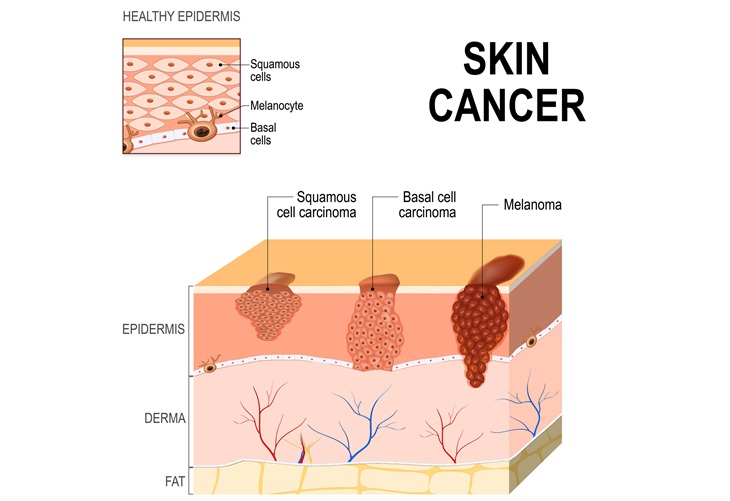
Genomic Test Could Reduce Lymph Node Biopsy Surgery in Melanoma Patients
Accurately determining whether melanoma has spread to the lymph nodes is crucial for guiding treatment decisions, yet the standard procedure—sentinel lymph node biopsy—remains invasive, costly, and unnecessary... Read more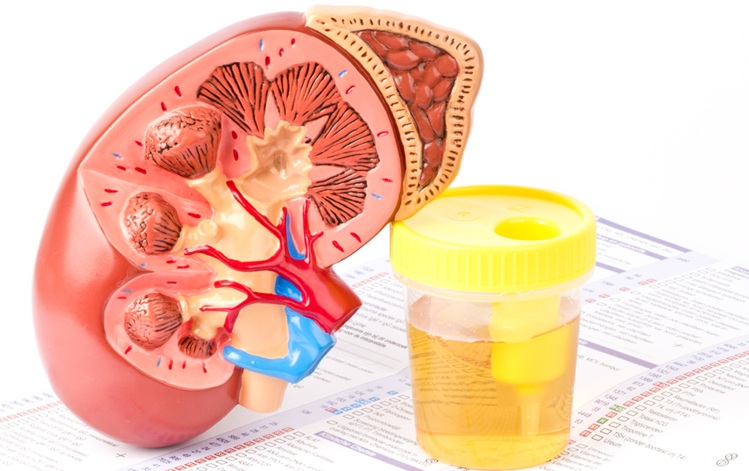
Urine Test Could Replace Painful Kidney Biopsies for Lupus Patients
Lupus is an autoimmune disorder that causes the immune system to attack the body’s own tissues and organs. Among the five million people living with lupus globally, nearly half develop lupus nephritis,... Read more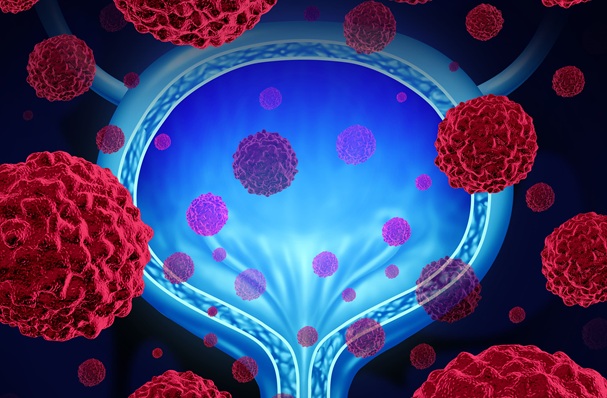
Blood Test Guides Post-Surgical Immunotherapy for Muscle-Invasive Bladder Cancer
After surgery for muscle-invasive bladder cancer, many patients face uncertainty about whether residual cancer cells remain in their bodies. Now, a new international phase 3 study has demonstrated that... Read more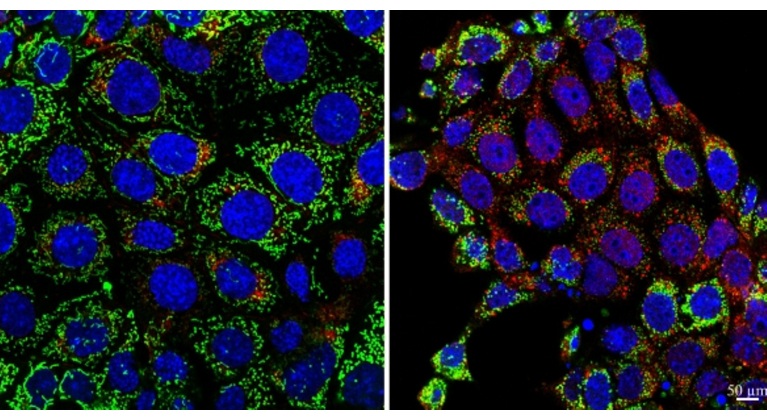
Mitochondrial DNA Mutations from Kidney Stressors Could Predict Future Organ Decline
Kidney-related diseases are alarmingly common: chronic kidney disease (CKD) affects more than one in seven U.S. adults, while about 20% of hospitalized adults are diagnosed with acute kidney injury (AKI).... Read moreHematology
view channel
Viscoelastic Testing Could Improve Treatment of Maternal Hemorrhage
Postpartum hemorrhage, severe bleeding after childbirth, remains one of the leading causes of maternal mortality worldwide, yet many of these deaths are preventable. Standard care can be hindered by delays... Read more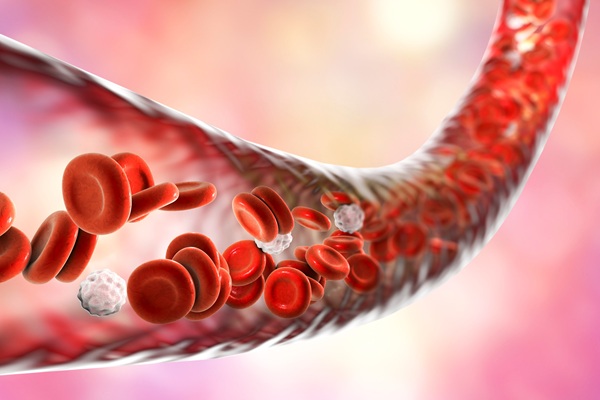
Pioneering Model Measures Radiation Exposure in Blood for Precise Cancer Treatments
Scientists have long focused on protecting organs near tumors during radiotherapy, but blood — a vital, circulating tissue — has largely been excluded from dose calculations. Each blood cell passing through... Read more
Platelets Could Improve Early and Minimally Invasive Detection of Cancer
Platelets are widely recognized for their role in blood clotting and scab formation, but they also play a crucial role in immune defense by detecting pathogens and recruiting immune cells.... Read more
Portable and Disposable Device Obtains Platelet-Rich Plasma Without Complex Equipment
Platelet-rich plasma (PRP) plays a crucial role in regenerative medicine due to its ability to accelerate healing and repair tissue. However, obtaining PRP traditionally requires expensive centrifugation... Read moreImmunology
view channel
Blood-Based Liquid Biopsy Model Analyzes Immunotherapy Effectiveness
Immunotherapy has revolutionized cancer care by harnessing the immune system to fight tumors, yet predicting who will benefit remains a major challenge. Many patients undergo costly and taxing treatment... Read more
Signature Genes Predict T-Cell Expansion in Cancer Immunotherapy
Modern cancer immunotherapies rely on the ability of CD8⁺ T cells to rapidly multiply within tumors, generating the immune force needed to eliminate cancer cells. However, the biological triggers behind... Read moreMicrobiology
view channel
Fast Noninvasive Bedside Test Uses Sugar Fingerprint to Detect Fungal Infections
Candida bloodstream infections are a growing global health threat, causing an estimated 6 million cases and 3.8 million deaths annually. Hospitals are particularly vulnerable, as weakened patients after... Read more
Rapid Sepsis Diagnostic Device to Enable Personalized Critical Care for ICU Patients
Sepsis is a life-threatening condition that occurs when the body’s response to infection spirals out of control, damaging organs and leading to critical illness. Patients often arrive at intensive care... Read morePathology
view channel
Tears Offer Noninvasive Alternative for Diagnosing Neurodegenerative Diseases
Diagnosing and monitoring eye and neurodegenerative diseases often requires invasive procedures to access ocular fluids. Ocular fluids like aqueous humor and vitreous humor contain valuable molecular information... Read more
AI-Powered Method Combines Blood Data to Accurately Measure Biological Age
Chronological age tells us how many years we’ve lived, but not how quickly our bodies are ageing. Some people stay healthy well into their 80s or 90s, while others experience decline much earlier.... Read moreTechnology
view channel
Embedded GPU Platform Enables Rapid Blood Profiling for POC Diagnostics
Blood tests remain a cornerstone of medical diagnostics, but traditional imaging and analysis methods can be slow, costly, and reliant on dyes or contrast agents. Now, scientists have developed a real-time,... Read more
Viral Biosensor Test Simultaneously Detects Hepatitis and HIV
Globally, over 300 million people live with Hepatitis B and C, and 40 million with HIV, according to WHO estimates. Diagnosing bloodborne viruses such as HIV and Hepatitis B and C remains challenging in... Read moreIndustry
view channel
Advanced Instruments Merged Under Nova Biomedical Name
Advanced Instruments (Norwood, MA, USA) and Nova Biomedical (Waltham, MA, USA) are now officially doing business under a single, unified brand. This transformation is expected to deliver greater value... Read more








 (3) (1).png)












